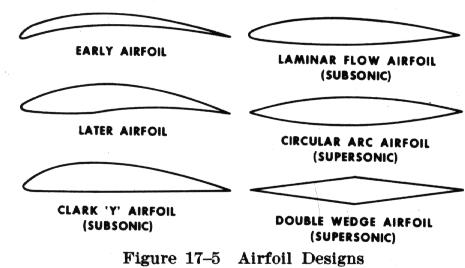| Airfoil Design
It is far from accidental that there is a basic similarity between the wings of birds and the wings of airplanes. A bird's wing is nothing more than an airfoil, and man has merely copied its shape, modified its design and structure, and developed mechanical power sources as substitutes for his own inadequacies in this area - and so he too flies. In the sections devoted to Newton's and Bernoulli's discoveries, we have already discussed in general terms the question of how a bird's wings or the wings of man's flying machine sustain flight when both the bird and the machine are heavier than air. Perhaps the explanation to the whole riddle can best be reduced to its most elementary concept by stating that lift (flight) is simply the result of fluid flow (air) about an airfoil - or in everyday language, the result of moving an airfoil (wing), by whatever means, through the air. Since it is the airfoil which harnesses the force developed by its movement through the air, we will further discuss and explain this "magic" structure, as well as some of the material presented in previous discussions on Messrs. Newton's and Bernoulli's laws. We can, in this way, emphasize the principles that are basic to an understanding of airfoils and airflow. An airfoil is a structure designed to obtain reaction upon its surface from the air through which it moves or that moves past such a structure. Air acts in various ways when submitted to different pressures and velocities; but we will confine this discussion to the parts of an airplane that we are most concerned with in flight; namely, the airfoils designed to produce lift. By looking at a
In Figure 17-4 note that the two extremities of the airfoil profile also differ in appearance. The end which faces forward in flight is called the leading edge, and is rounded, while the other end, the trailing edge, is quite narrow and tapered. A reference line often used in discussing the airfoil is the chord line, a straight line drawn through the profile connecting the extremities of the leading and trailing edges. The distance from this chord line to the upper and lower surfaces of the wing denotes the magnitude of the upper and lower camber at any point. Another reference line, drawn from the leading edge to the trailing edge, is the "mean camber line." This mean line is equidistant at all points form the upper and lower contours. The construction of the wing so as to provide actions greater than its weight, is done by shaping the wing (Fig. 17-4) so that advantage can be taken of the air's response to certain physical laws, and thus develop two actions from the air mass; a positive pressure lifting action from the air mass below the wing, and a negative pressure lifting action from lowered pressure above the wing. As the airstream strikes the relatively flat lower surface of the wing when inclined at a small angle to its direction of motion, the air is forced to rebound downward and therefore causes an upward reaction in positive lift, while at the same time airstream striking the upper curved section of the "leading edge" of the wing is deflected upward. In other words, a wing shaped to cause an action on the air, and forcing it downward, will provide an equal reaction from the air, forcing the wing upward. If a wing is constructed in such form that it will cause a lift force greater than the weight of the airplane, the airplane will fly. Probably you have held your flattened hand out of the window of a moving automobile. As you inclined you hand to the flow of air, the force of air against it pushed it up. Without realizing it you were demonstrating how an airplane gets a portion of its lift. The "wing," in this case your hand, pushed against the air, the air pushed back - remember Newton's third law? As we have already learned, the upward component of this force is called lift. However, if all the lift required were obtained merely from the deflection of air by the lower surface of the wing, an airplane would need only a flat wing like a kite. This, of course, is not the case at all; under certain conditions disturbed air currents circulating at the trailing edge of the wing could be so excessive as to make the airplane lose speed and lift. The balance of the lift needed to support the airplane comes from the flow of air above the wing. Herein lies the key to flight. The fact that most lift is the result of the airflow's downwash from above the wing, must be thoroughly understood in order to continue further in the study of flight. It is neither accurate nor does it serve a useful purpose, however, to assign specific values to the percentage of lift generated by the upper surface of an airfoil versus that generated by the lower surface. These are not constant values and will vary, not only with flight conditions, but with different wing designs. It should be understood that different airfoils have different
flight characteristics. Many thousands of airfoils have been tested in wind
tunnels and in actual flight, but no one airfoil has been found that satisfies
every flight requirement. The weight, speed, and purpose of each airplane
dictate the shape of its airfoil. It was learned many years ago that the most
efficient airfoil for producing the greatest lift was one that had a concave, or
"scooped out" lower surface. Later it was also learned that as a fixed design,
this type of airfoil sacrificed too much speed while producing lift and,
therefore, was not suitable for high speed flight. It is interesting to note,
however, that through advanced progress in engineering, today's high speed jets
can again take advantage of the concave airfoil's high lift characteristics.
Leading edge (Kreuger) flaps and trailing edge (Fowler) flaps, when extended
from the basic wing structure, literally change the airfoil shape into the
classic concave form, thereby generating much greater lift during slow flight
conditions.
|


